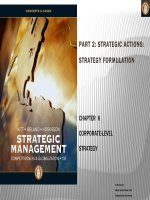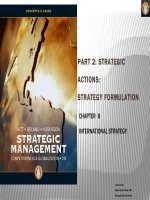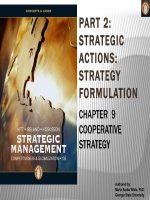Chapter 11 strategic management competitiveness and globalization 10e
Bạn đang xem bản rút gọn của tài liệu. Xem và tải ngay bản đầy đủ của tài liệu tại đây (864.14 KB, 70 trang )
PART 3: STRATEGIC
ACTIONS:
STRATEGY
IMPLEMENTATION
CHAPTER 11
ORGANIZATIONAL
STRUCTURE AND
CONTROLS
Authored by:
Marta Szabo White, PhD.
Georgia State University
THE STRATEGIC MANAGEMENT PROCESS
©2013 Cengage Learning. All Rights Reserved. May not be copied, scanned, or duplicated, in whole or in part, except for use as
permitted in a license distributed with a certain product or service or otherwise on a password-protected website for classroom use.
KNOWLEDGE OBJECTIVES
● Define organizational structure and controls and
discuss the difference between strategic and financial
controls.
● Describe the relationship between strategy and
structure.
● Discuss the functional structures used to implement
business-level strategies.
©2013 Cengage Learning. All Rights Reserved. May not be copied, scanned, or duplicated, in whole or in part, except for use as
permitted in a license distributed with a certain product or service or otherwise on a password-protected website for classroom use.
KNOWLEDGE OBJECTIVES
● Explain the use of three versions of the
multidivisional (M-form) structure to implement different
diversification strategies.
● Discuss the organizational structures used to
implement three international strategies.
● Define strategic networks and discuss how strategic
center firms implement such networks at the business,
corporate, and international levels.
©2013 Cengage Learning. All Rights Reserved. May not be copied, scanned, or duplicated, in whole or in part, except for use as
permitted in a license distributed with a certain product or service or otherwise on a password-protected website for classroom use.
OPENING CASE
ANOTHER ONE BITES THE DUST: BORDERS DECLARES BANKRUPTCY
■ Founded in 1971, one of the original superstore
book retailing chains, Borders, declared bankruptcy
in 2011 with debts of $1.293 billion and assets of
$1.275 billion.
■ This case underscores the importance of strategy
implementation. While Borders crafted an innovative
strategy with knowledgeable employees, a worldclass inventory system, and even espresso before
Starbucks made it popular, their implementation
was their Achilles’ heel.
©2013 Cengage Learning. All Rights Reserved. May not be copied, scanned, or duplicated, in whole or in part, except for use as
permitted in a license distributed with a certain product or service or otherwise on a password-protected website for classroom use.
OPENING CASE
ANOTHER ONE BITES THE DUST: BORDERS DECLARES BANKRUPTCY
■ Initial strategy worked well
● 1991 - Borders sold the relatively small bookstore
chain and inventory system to Kmart
● 1995 - Borders was spun off with an IPO
■ Bankruptcy through a series of blunders
● International diversification reduced Borders’ focus
on the most lucrative book retailing market in the U.S.
● When Barnes & Noble developed the capability to
sell online, Borders outsourced this to Amazon, which
sent customers and business to a major competitor.
©2013 Cengage Learning. All Rights Reserved. May not be copied, scanned, or duplicated, in whole or in part, except for use as
permitted in a license distributed with a certain product or service or otherwise on a password-protected website for classroom use.
OPENING CASE
ANOTHER ONE BITES THE DUST: BORDERS DECLARES BANKRUPTCY
■ 2007- a Borders store in Madison, Wisconsin,
had no Internet!
■ Borders had incredibly bad management,
especially at the higher levels of the firm
■ It was unable to correct these problems because
of an inadequate structure and a focus on financial
engineering (financial controls), both of which
crippled its ability to respond effectively to changes
in the marketplace and to implement its strategies
(e.g., international strategy) effectively
©2013 Cengage Learning. All Rights Reserved. May not be copied, scanned, or duplicated, in whole or in part, except for use as
permitted in a license distributed with a certain product or service or otherwise on a password-protected website for classroom use.
INTRODUCTION
Strategy may be implemented via:
•
Structure
•
Reward mechanisms
•
Organizational culture
•
Leadership
This chapter focuses on structure.
IMPORTANT: The match or degree of fit between
strategy and structure influences the firm’s
ability to earn above-average return.
©2013 Cengage Learning. All Rights Reserved. May not be copied, scanned, or duplicated, in whole or in part, except for use as
permitted in a license distributed with a certain product or service or otherwise on a password-protected website for classroom use.
INTRODUCTION
● Organizational structure and controls provide the
framework within which strategies (business,
corporate, international and cooperative) are used
● No one structure is the best for all organizations
● The choice of structure and controls should
support the strategic goals of the firm
● Structure will change as the strategy of the
organization changes
● Effective strategic leadership means selecting
the appropriate structure.
©2013 Cengage Learning. All Rights Reserved. May not be copied, scanned, or duplicated, in whole or in part, except for use as
permitted in a license distributed with a certain product or service or otherwise on a password-protected website for classroom use.
ORGANIZATIONAL STRUCTURE
AND CONTROLS
Structure and Firm
Per formance
•
Research suggests that performance declines
when the firm’s strategy is not matched with
the most appropriate structure and controls
•
Example: CEO Jeffrey Immelt recognized the
need to match strategy and structure during
the recent economic downturn, as evidenced
by the restructuring alignments in GE Capital,
GE’s financial service group
©2013 Cengage Learning. All Rights Reserved. May not be copied, scanned, or duplicated, in whole or in part, except for use as
permitted in a license distributed with a certain product or service or otherwise on a password-protected website for classroom use.
ORGANIZATIONAL
STRUCTURE
Organizational structure
•
Specifies the firm’s formal reporting
relationships, procedures, controls, and
authority and decision-making processes
•
Specifies the work to be done and how to do
it, given the firm’s strategy or strategies
•
Is the pivotal component of effective strategy
implementation
It is critical to match organizational structure
to the firm’s strategy
©2013 Cengage Learning. All Rights Reserved. May not be copied, scanned, or duplicated, in whole or in part, except for use as
permitted in a license distributed with a certain product or service or otherwise on a password-protected website for classroom use.
ORGANIZATIONAL
STRUCTURE
Strategy pioneer Alfred Chandler found organizations
change their structures when inefficiencies force them
to.
•
A firm’s strategy is supported when its structure is
properly aligned to its strategy
•
Two considerations regarding alignment
1.
Structural stability: capacity firm requires to
consistently and predictably manage its daily work
routines
2.
Structural flexibility: opportunity to explore
competitive advantages firm will need to be
successful in the future
Source: A. Chandler, 1962, Strategy and Structure, Cambridge, MA: MIT Press.
©2013 Cengage Learning. All Rights Reserved. May not be copied, scanned, or duplicated, in whole or in part, except for use as
permitted in a license distributed with a certain product or service or otherwise on a password-protected website for classroom use.
ORGANIZATIONAL
CONTROLS
Controls guide the use of strategy,
indicate how to compare actual
results with expected results, and
suggest corrective actions to take
when the difference is unacceptable.
Two types:
1.
Strategic Controls
2.
Financial Controls
©2013 Cengage Learning. All Rights Reserved. May not be copied, scanned, or duplicated, in whole or in part, except for use as
permitted in a license distributed with a certain product or service or otherwise on a password-protected website for classroom use.
STRATEGIC CONTROLS
Largely SUBJECTIVE criteria intended to verify that the firm is
using appropriate strategies for the conditions in the external
environment and the company’s competitive advantages.
•
•
•
Are concerned with examining the fit between:
•
What the firm might do (opportunities in its external
environment)
•
What the firm can do (competitive advantages)
Evaluate the degree to which the firm focuses on the
requirements to implement strategy
•
Business-level: primary and support activities
•
Corporate-level (related): sharing of knowledge, markets, and
technologies across businesses
Focus on the content of strategic actions
©2013 Cengage Learning. All Rights Reserved. May not be copied, scanned, or duplicated, in whole or in part, except for use as
permitted in a license distributed with a certain product or service or otherwise on a password-protected website for classroom use.
FINANCIAL CONTROLS
Largely OBJECTIVE criteria used to measure firm’s
performance against previously established quantitative
standards
•
Focus on short-term financial outcomes
•
Include accounting-based measures
•
•
ROI (return on investment)
•
ROA (return on assets)
Include market-based measures
•
EVA (economic value added)
•
Produce risk-averse managerial decisions
•
Are essential when a firm pursues a strategy with
unrelated diversification
©2013 Cengage Learning. All Rights Reserved. May not be copied, scanned, or duplicated, in whole or in part, except for use as
permitted in a license distributed with a certain product or service or otherwise on a password-protected website for classroom use.
ORGANIZATIONAL STRUCTURE
AND CONTROLS
Structure’s effectiveness is determined by using both strategic and financial controls.
©2013 Cengage Learning. All Rights Reserved. May not be copied, scanned, or duplicated, in whole or in part, except for use as
permitted in a license distributed with a certain product or service or otherwise on a password-protected website for classroom use.
RELATIONSHIPS BET WEEN
STRATEGY AND STRUCTURE
● RECIPROCAL RELATIONSHIP change in one typically causes a
change in the other, underscoring the
interconnectedness between strategy
formulation and strategy
implementation
STRATEGY
STRUCTURE
● Strategy typically has a much more
important influence on structure than
structure on strategy
©2013 Cengage Learning. All Rights Reserved. May not be copied, scanned, or duplicated, in whole or in part, except for use as
permitted in a license distributed with a certain product or service or otherwise on a password-protected website for classroom use.
EVOLUTIONARY PATTERNS OF
STRATEGY AND ORGANIZATIONAL
STRUCTURE
Chandler found that firms tend to
grow in predictable patterns:
● first by volume
● then by geography
● then by integration (vertical, horizontal)
● finally through product/business
diversification
Growth pattern determines
structure!
Source: A. Chandler, 1962, Strategy and Structure, Cambridge, MA: MIT Press.
©2013 Cengage Learning. All Rights Reserved. May not be copied, scanned, or duplicated, in whole or in part, except for use as
permitted in a license distributed with a certain product or service or otherwise on a password-protected website for classroom use.
EVOLUTIONARY PATTERNS OF
STRATEGY AND ORGANIZATIONAL
STRUCTURE
■ Firms typically alter their
structure as they grow in size and
complexity
■ Three key structural forms used
to implement strategies:
•
•
•
Simple structure
Functional structure
Multidivisional structure (M-form)
©2013 Cengage Learning. All Rights Reserved. May not be copied, scanned, or duplicated, in whole or in part, except for use as
permitted in a license distributed with a certain product or service or otherwise on a password-protected website for classroom use.
EVOLUTIONARY PATTERNS OF
STRATEGY AND ORGANIZATIONAL
STRUCTURE
FIGURE 11.1
Strategy
Structure
Growth Pattern
©2013 Cengage Learning. All Rights Reserved. May not be copied, scanned, or duplicated, in whole or in part, except for use as
permitted in a license distributed with a certain product or service or otherwise on a password-protected website for classroom use.
STRATEGY AND STRUCTURE:
SIMPLE STRUCTURE
● Owner-manager makes all major
decisions and monitors all activities
● Staff acts as extension of manager's
supervisory authority
● Matched focus strategies and businesslevel strategies: these firms offer single
product lines in single geographic
markets
● Few rules, limited task specialization,
basic technology system
● With size comes complexity and
managerial and structural challenges;
firms tend to move from a simple to a
©2013 Cengage Learning. All Rights Reserved. May not be copied, scanned, or duplicated, in whole or in part, except for use as
permitted in a license distributed with a certain product or service or otherwise on a password-protected website for classroom use.
STRATEGY AND STRUCTURE:
FUNCTIONAL STRUCTURE
● CEO and a limited corporate staff make
all decisions.
● Functional line managers are in
dominant organizational areas
Production
Marketing
Engineering R&D
Accounting
Human resources
● WITHIN – functional specialization
results in
active knowledge sharing
within each area
● BETWEEN – impedes communication
and coordination among different
©2013 Cengage Learning. All Rights Reserved. May not be copied, scanned, or duplicated, in whole or in part, except for use as
permitted in a license distributed with a certain product or service or otherwise on a password-protected website for classroom use.
STRATEGY AND STRUCTURE:
FUNCTIONAL STRUCTURE
● Facilitates career paths and professional
development in specialized functional
areas
● Causes functional-area managers to
focus on local versus overall company
strategic issues
● Supports implementing business-level
strategies and some corporate-level
strategies (e.g., single or dominant
business) with low levels of
diversification
● When changing from a simple to a
©2013 Cengage Learning. All Rights Reserved. May not be copied, scanned, or duplicated, in whole or in part, except for use as
permitted in a license distributed with a certain product or service or otherwise on a password-protected website for classroom use.
STRATEGY AND STRUCTURE:
MULTIDIVISIONAL (M-FORM)
STRUCTURE
● Operating divisions each represent a
separate business or profit center
● Top corporate officer delegates
responsibilities for day-to-day operations
and business-unit strategies to division
managers
● Ties together all operating divisions
● Each division represents a separate
business or profit center with its own
functional hierarchy
● Each division is responsible for daily
operations
©2013 Cengage Learning. All Rights Reserved. May not be copied, scanned, or duplicated, in whole or in part, except for use as
permitted in a license distributed with a certain product or service or otherwise on a password-protected website for classroom use.
STRATEGY AND STRUCTURE:
MULTIDIVISIONAL (M-FORM)
STRUCTURE
Appropriate structure as firms DIVERSIFY
Three Major Benefits
● Simplifies the problem of control
through more accurate monitoring of
the performance of each business
● Facilitates comparisons between
divisions, which improves the resource
allocation process
● Stimulates managers of poorly
performing divisions to look for ways of
improving performance
©2013 Cengage Learning. All Rights Reserved. May not be copied, scanned, or duplicated, in whole or in part, except for use as
permitted in a license distributed with a certain product or service or otherwise on a password-protected website for classroom use.









